CHAPTER 10
CRYSTALS AROUND THE WORLD

Picture #69
Twelve-inch-long Smoky Black Quartz
from Fresno, California
Black quartz, sometimes known as Morion quartz or cairngorm, (from the Cairngorm Mountains, Scotland,) can be completely dense and opaque.
Alternately, it could be darkly colored with complete transparency.
The dark color is caused by x-rays in the form of cosmic energy and earth radiation that shift the color of the crystal from clear to black over millions of years.
The “background radiation” of our planet and solar system has helped crystals, humans and all life to evolve.
The energetic frequencies of x-rays help many crystals and gems change their colors.
In a similar fashion, high-energy ultraviolet rays in sunlight can also create color changes in quartz and other gems.
In the chapter on quartz colors, you will see more about these interactions of photons and x-ray energy.
The energies of x-rays and ultraviolet light are generally considered harmful to human life.
However, I have found that biological life forms and crystals have developed successful evolutionary mechanisms to utilize the high-energy rays of many naturally powerful radiation sources.
Sunlight, UV light and background radiation are all necessary energies to support plant & animal life on earth.
Radiation triggers favorable mutations in most species as well as stimulating the immune systems of animals and people.
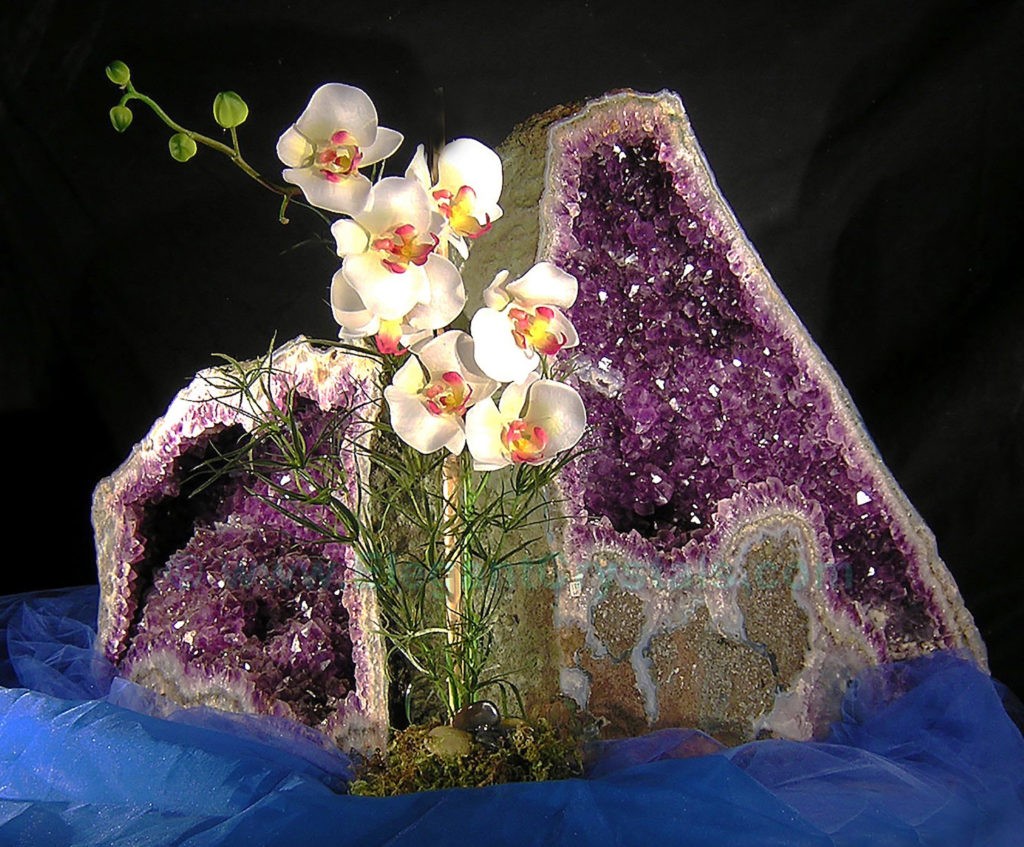
Picture #70
125-pound Brazilian Amethyst Geode with Two Cave Openings
In Brazil, minerals are often found in tube-like caves called geodes.
The amethyst crystal cluster shown above took on the shape of a tunnel with two entrances.
It weighs about 125 pounds.
My friends and I did not have very much fun putting it up on a six-foot-high shelf.
Once it was carefully placed, I thought it had an impressive presence.
I like to think of this cave as holding a dragon’s treasure at the mysterious center.
Usually, I place a clear crystal ball on a cushion at the center of the cave.
When you peek in, you can find the gem treasure.
The Brazilians call these geodes “cathedrals.”
Geodes, usually amethyst or citrine, are often tall and elongated.
They look like the naves of churches.
Cathedral clusters can be violet, white, blue, pink, yellow, orange, red, lilac, black, or tan.
The largest ones are over 15 feet tall.
Amethyst cathedral shapes are formed when large bubbles of gas are trapped in molten magma, i.e., liquid rock.
The bubbles drift upwards, leaving oval cavities, which then fill up with amethyst and quartz crystal growth.
Once mined, large geodes are reinforced with glue, wires and cement to strengthen the thin agate shell around the amethyst.
From the outside, the geodes look like dusty green boulders.
When they are sawed or chiseled open, you can see the amazing colors inside.
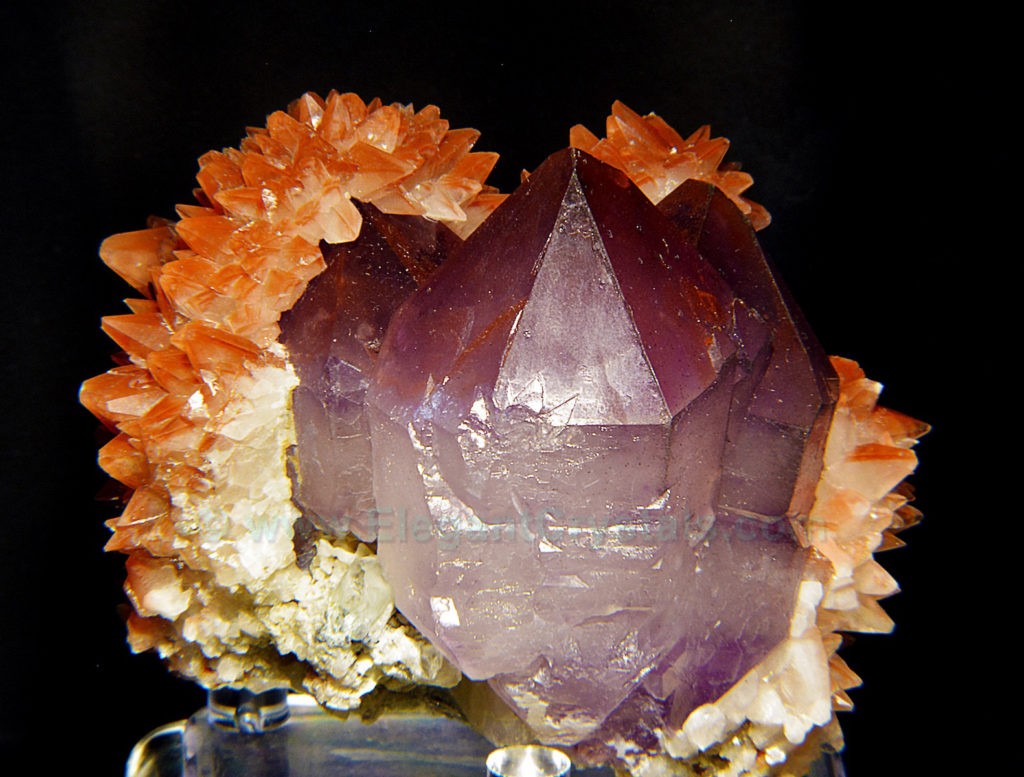
Picture #71
3-inch-tall Twinned Mexican Amethyst with Calcite Coating
This three-inch-wide Mexican specimen shows how calcite can form around amethyst crystals.
The amethyst cluster has a little bit of hematite, an iron compound, coating its faces.
You can see this reddish coating at the tips of the amethyst.
The calcite probably covered the entire amethyst specimen when it grew in the ground.
Chances are, some of the calcite broke off during the mining process, uncovering the crystal inside.
You can see how the hematite also covered, and colored, the calcite.
Alternately, one of the miners may have pulled off some of the extra calcite so he could see the purple formation at the center.
Either way it occurred, this amazing specimen reminds me of a little purple city with radiating rays of light shining forth from it.
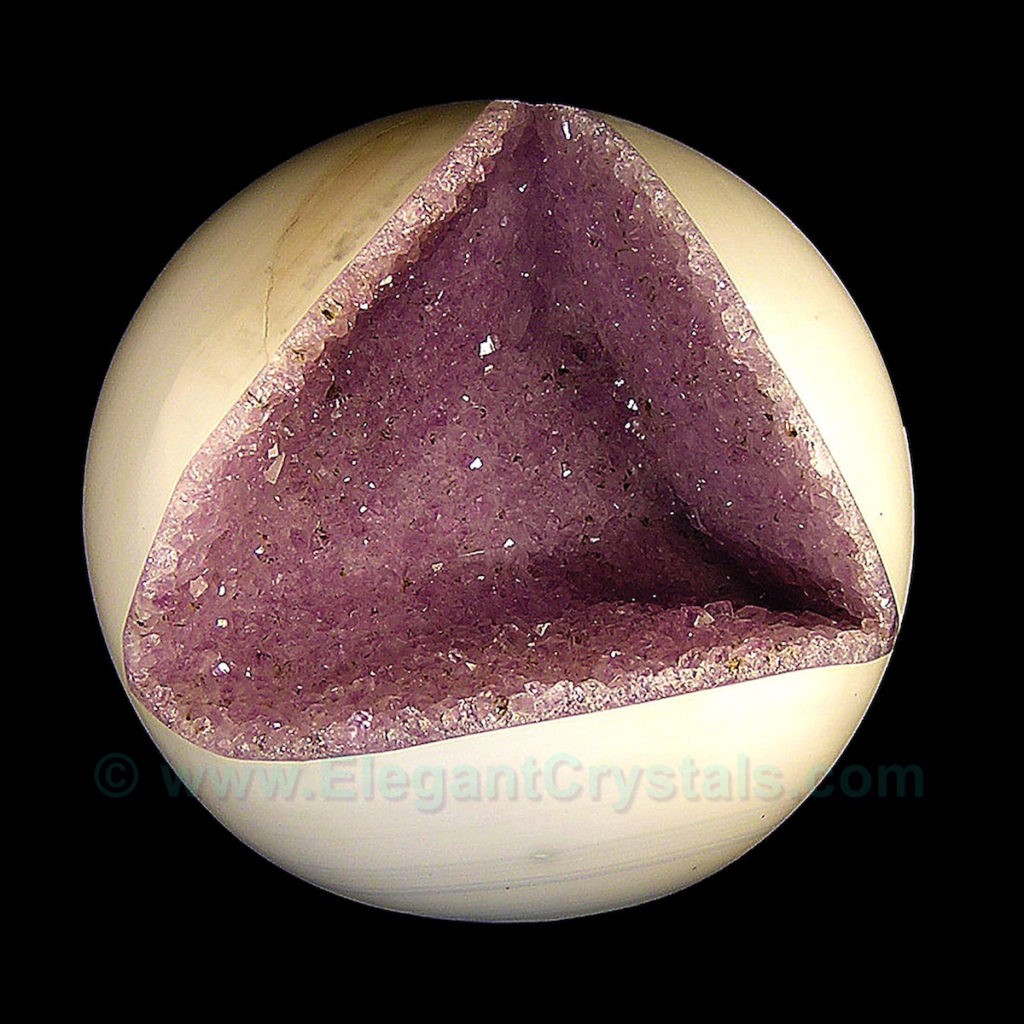
Picture #72
6-inch-wide Brazilian White Agate Ball
with Included Amethyst Geode
Somebody came up with a great concept here!
He found a small geode inside of solid white agate rock, and turned it into a striking crystal ball with clever carving.
This is perhaps the whitest agate I have ever seen come out of the ground.
The geode inside has flat sides covered with thin sheets of tiny amethyst crystals.
This is an example of a pseudomorph, formed when the agate trapped a soluble crystal, like fluorite, halite or selenite.
Once the internal crystal dissolved away, a flow of chemical-laden water allowed new amethyst crystals to form inside the tiny pressure cooker.
All crystals in the earth form in caves that contain mineral-laden water or molten rocks.
The caves may be flat cracks up to 100 yards long.
Alternately, bubbles in lava may form the cave.
All quartz crystals are created from liquid solutions containing silica (SiO2, silicon dioxide.)
The solutions contain silica and also water, gases, and other trace elements and minerals.
Generally, crystals form on the walls of the cave,
but crystals can also grow as “floaters,” supported by the dense liquid solution.
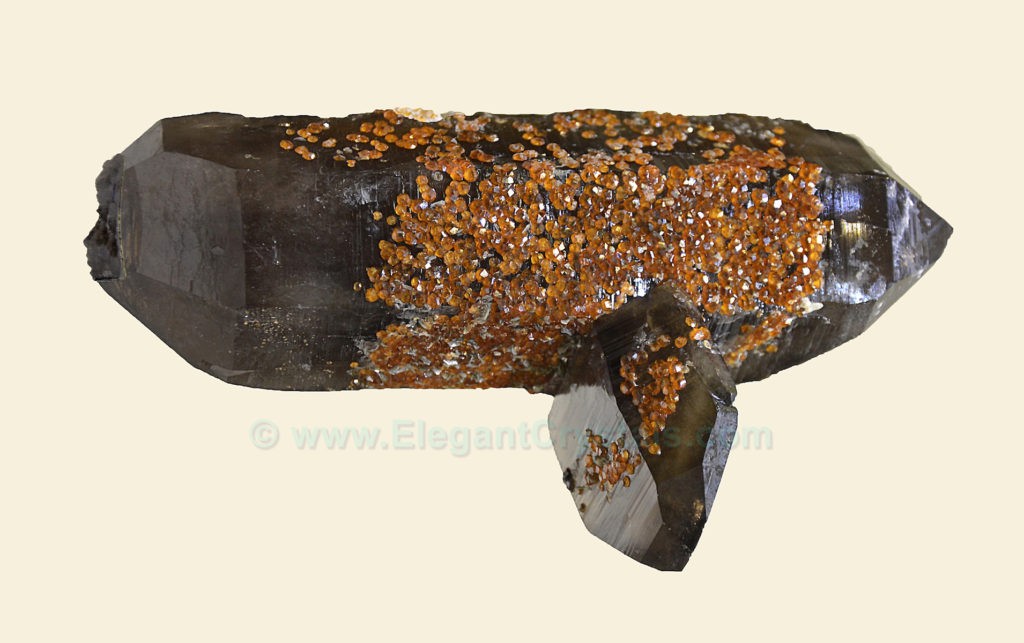
Picture #73
4-inch-tall Chinese Smoky Quartz with Garnets
Unlike the previous picture, this specimen is not a pseudomorph.
In this case, the smoky quartz crystal formed first and then was coated by small orange garnet crystals.
The little garnet crystals are often fragile and insecurely adhered to the quartz.
I have seen many of them fall off during handling of various crystals.
I call this shape a “crystal pistol” because it has what looks like a handgrip and a barrel.
I will try not to confuse you with these descriptive names because they are not officially recognized as mineral names.
There are, however, official databases of specific mineral names that correspond to unique chemical compounds in the mineral world.
These official names are used in scientific correspondence and published articles.
Then the reader knows exactly which stone the author is talking about.
Some mineral dealers make up trademarked names for their stones
that do not really correspond to specific minerals.
When you see a trademark symbol next to a mineral name, this indicates an unofficial, unregistered name.
The Internet can help you discover which names are scientifically recognized and which ones are merely trade names.
Please check out www.mindat.org

Picture #74
Six-inch-tall Swiss Gwindel
Curved Smoky Citrine Quartz
This unusual crystal from Switzerland is another type of quartz twin called a “gwindel.”
Very few locations put out parallel twin crystals like this, where new crystals grow sideways from the original one in a curved configuration.
I would call this a multiple-terminated smoky citrine crystal.
I like this particular formation because once again it reminds me of a crystal city.
The gwindels from the Swiss Alps are probably the finest that have ever been found.
The visual effect of a city skyline is particularly strong with this type of formation.
Gwindels are different from most other quartz crystals.
They show a flat, layered appearance.
When the gwindels are growing, the new crystals twist slightly in relation to the previous ones.
These interesting pieces have unique curvature in the tabular crystals.
You may recall that tabular crystals, also known as tabbies, have a large flat configuration where the length and width of the specimen are much larger than the thickness.
Gwindels seldom grow over one inch thick but can have lengths of eight inches or more.
Typically, a gwindel crystal will be four or five inches wide.

Picture #75
Brazilian Twinned Smoky Quartz, 12-inches-long
The crystal cities from Brazil seldom take on gwindel configurations.
More typically, they have many parallel points as we can see in the crystal above.
This Dauphiné twin gives you an idea of just how many parallel points can form in a small area.
The photo shows two inches of the tip of a foot-long crystal.
I guess you could call this a crystal city or even a crystal castle depending on your point of view.
Either way, the crystal creates a striking architectural resemblance.
Did ancient builders find crystal cities that weathered out of the ground?
Did they use them as inspiration for their structural plans?
Ancient architects seldom worked from blueprints as we know them.
I believe they actually “grew” their buildings, following the crystalline patterns they found in nature.
Most building stones are quarried out of rocks that contain crystalline structures.
On many levels, we live in buildings modeled after basic crystalline shapes.

Picture #76
Ten-inch-tall Brazilian Citrine Quartz
Brazilian crystal castles occur in many different colors.
The citrine castles are desirable because of their beautiful gold color tones.
Over the years, I have found a few citrine castles as well as amethyst, smoky and ice clear crystal palaces.
I think these are the most complex and interesting shapes that exist in the mineral kingdom.
Somehow, holding a crystal city always makes me feel like I am at home.
In the picture above, perhaps you can get a sense of how the crystals spiral around each other.
Please start by looking at the crystal in the lower right-hand corner.
Follow the patterns around to the left, then back to the right and finally, to the left, ending in the large central crystal.
If you are looking down the point of the crystal, you will see a complete spiral surrounding the large crystal in the center.
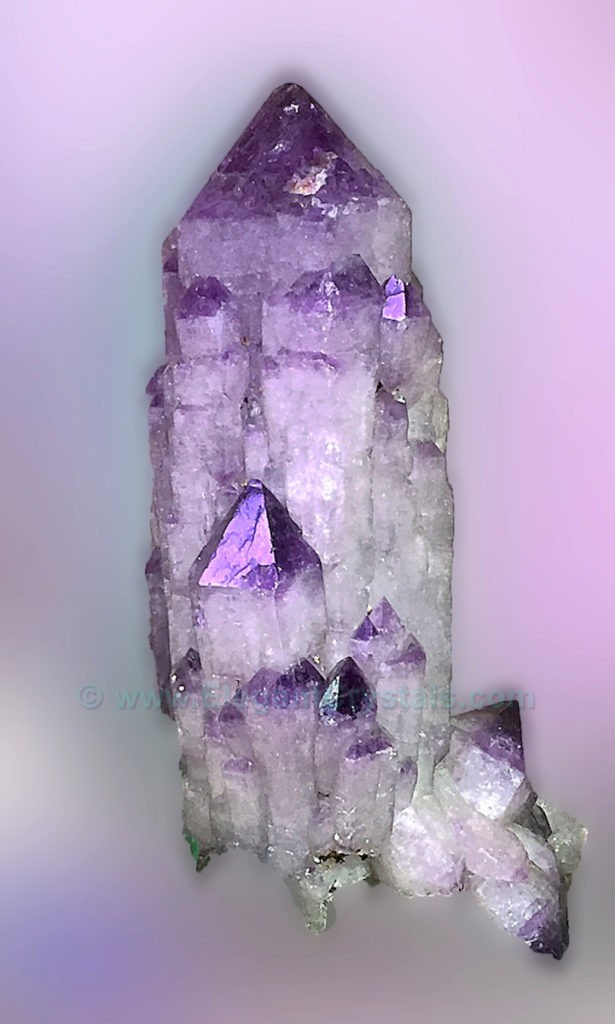
Picture #77
8-inch Brazilian Amethyst Quartz
With Spiraling Points Around a Central Crystal
